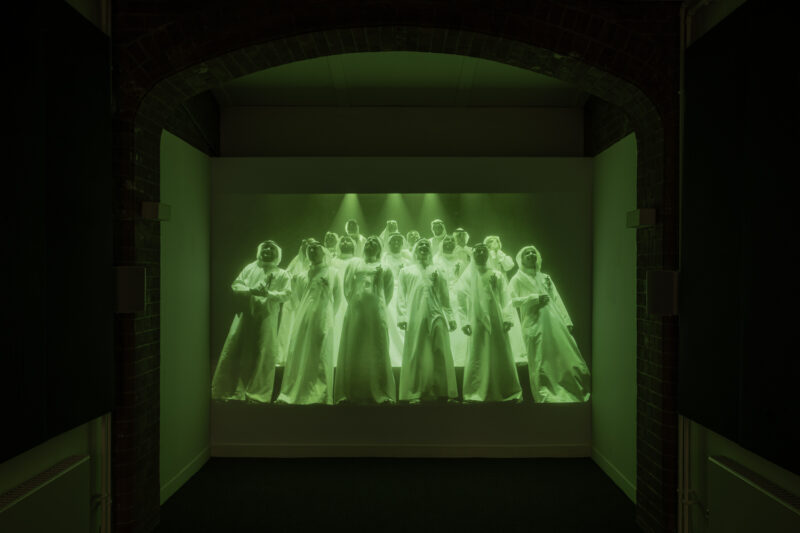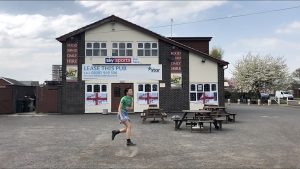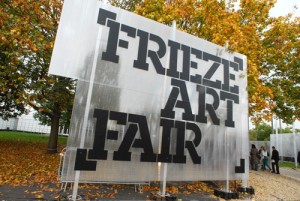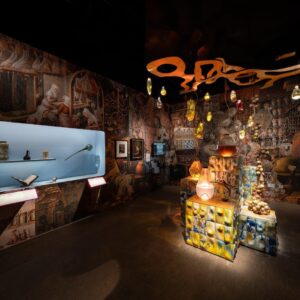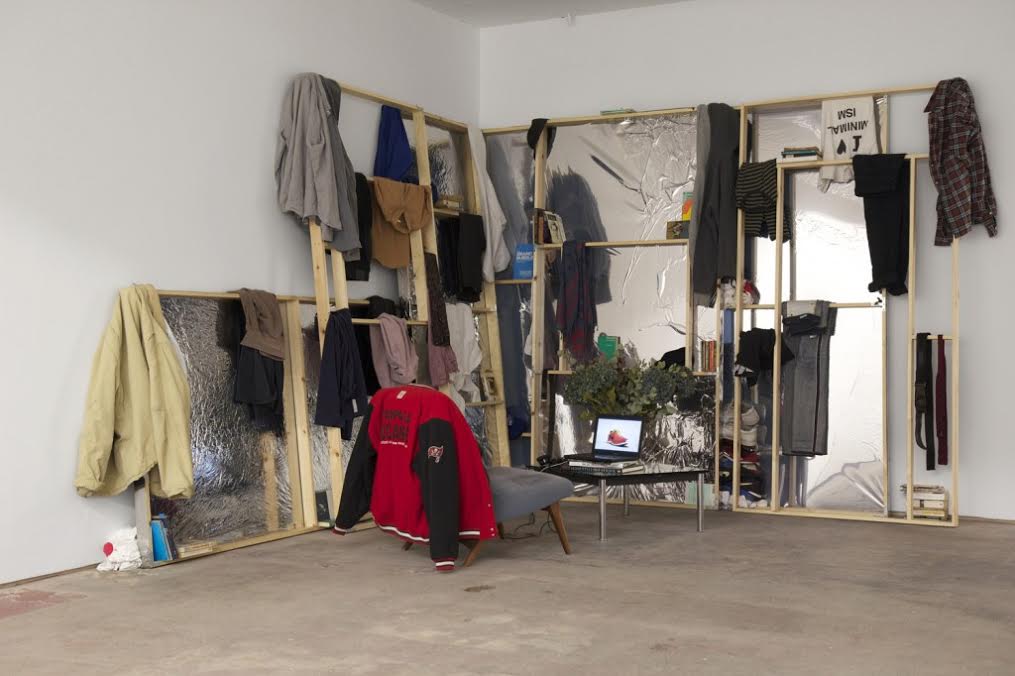
David Raymond Conroy, 2010 – 2014, 2015. Artist’s clothes, artist’s books, wood, privacy film, Parker Knoll chair, Le Corbusier LC4 table, vase, dried flowers Production and Marketing, 2014/15 Single channel HD video 7 mins. Courtesy of the artist and Seventeen Gallery
David Raymond Conroy is a London based artist. Recent projects include Prosu(u)mer at EKKM, Tallinn, London, A Shared Space of Difference, Camden Arts Centre, London, PPE, or It is Spring and I am Blind, Modern Art Oxford and Staging Brief Interviews with Hideous Men with Andy Holden, ICA, London and Arnolfini, Bristol. Recent group projects include; Gesamtzusammenhang at Kunst Halle Sankt Gallen, Emotional Supply Chains at 176 and Performance Capture at Stedelijk Museum, Amsterdam.
We first discovered your work in 2016 at the group show Emotional Supply Chains at Zabludowicz Collection. You were showing the video (You (People) Are All The Same) which came out of your time spent on residency in Las Vegas. The video ends up as an examination of your attempts to make a new artwork based on encounters with the city’s homeless population. Why did this become the focus of the work?
I arrived in Las Vegas with the intention of making a video about my relationship with America in quite broad terms. I grew up in the 1990s in a commuter town just outside London but I was somehow saturated with American culture (hip hop, skateboarding, movies, basketball, TV series, etc etc); whilst on the residency it was my intention to explore the gap between the idea I had of America and an actual experience of being there. In a way, this plan was sort of derailed by the homelessness problem that I witnessed in Vegas but at the same time, by chance, it became a way to more clearly think through the disjunct I felt between “The American Dream” and the reality. Perhaps that sounds quite banal, but I can only say that I was totally shocked by the number of homeless people I saw, and the sense I had that they had really been failed or abandoned by a system that did not regard them as profitable. In quite a straightforward way, this made me think about what I could do or should do from the position I was in; as someone who had been given a bit of money to make an artwork, and to question what my responsibilities are in this situation. This prompted a whole tumble of knots and crises about privilege and power and the value of art, of Political art and a million other things that I just couldn’t resolve. For me this sort of irresolvable situation is actually where art functions best.
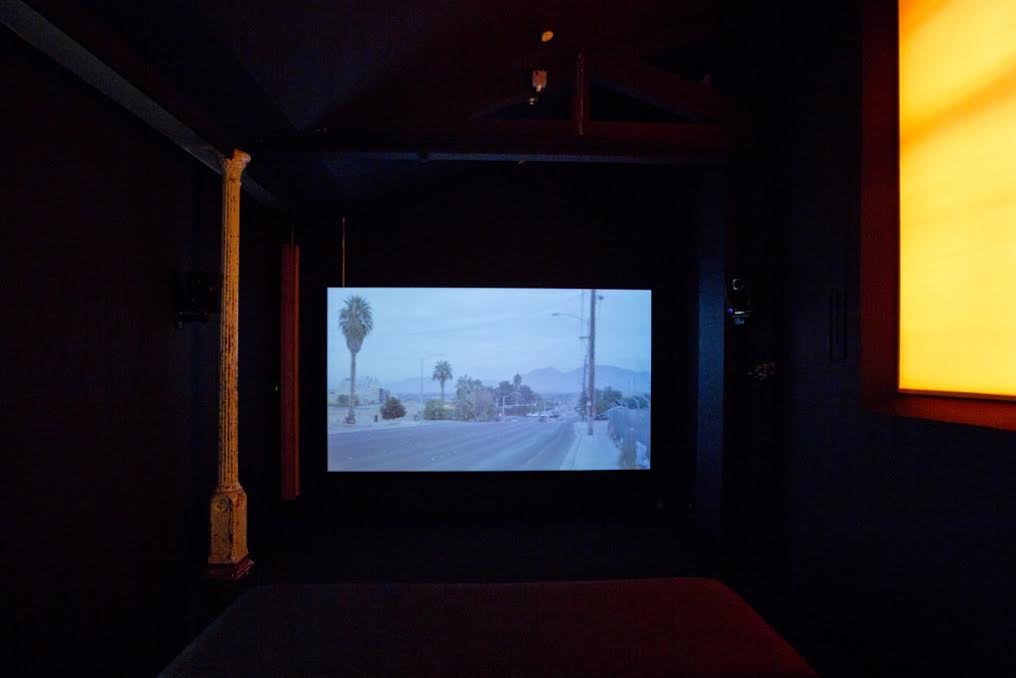
David Raymond Conroy, (You (People) Are All The Same), 2016 Single channel video with sound
Installation view at Emotional Supply Chains, Zabludowicz Collection, London (2016). Curated by Paul Luckraft. Courtesy of the artist and Seventeen Gallery
One of the things that struck me most about the video was its dual nature: it functions as a work in itself but in some ways, sidesteps or toys with the ‘requirement’ to actually make something. Can you talk a bit about this?
The difficulty of making the work I decided to make, both morally and logistically meant that I ended up not getting to the place I was aiming for at the outset. What I had though, in the end, was the footage I had been shooting along the way and so that is what I chose to work with. I made some choices early on when I was filming, for instance I didn’t want to point the camera at anyone or record anyone until they were contractually engaged with the project, so this meant that a lot of what I had on camera was kind of meandering and accidental seeming but when I came to edit this footage it felt like it actually worked well in the speculative realm that the work ends up occupying. So, I had all this footage of empty streets and vacant lots and I was trying to write up what I had been doing but not filming, thinking about what form the work could take that would somehow make sense of the whole situation – Las Vegas, art residencies, generosity, homelessness, gambling, winning, losing… It occurred to me that whilst I was on the residency I had been listening to the podcast Serial and then these other true crime docudrama things and these started to seem to epitomise certain things about contemporary U.S. culture – the reservations I had about it, and the enthralling, exciting nature of it, and this felt as though it was somehow in a similar ethical terrain to what I was thinking about with my project. These podcasts also seemed to really spin out very little concrete information into these addictive stories. So, it seemed like it could work to propose this mode of an unfurling investigation and a kind of journalistic approach, which if it is done well can be compelling enough that in the end it doesn’t really matter whether it achieves its initial aims.
The idea of the artist residency itself is something that you seem to be grappling with in the video, especially as this particular residency took place in a city very unfamiliar to you. How do you view something like an artist residency where an artist is planted for a designated amount of time in a new place?
For me the residency model works well, though perhaps that is because I don’t expect them to have the kind of long lasting structural or political impact that they are sometimes accused of being inadequate to. I work reactively and so simply being in a new place and the process of trying to figure out how I can navigate that space works well for me. I’m interested in art that creates and allows for a certain kind of social realm and residencies are a kind of concentrated version of that. I have particular concerns that always return and I can’t escape these, so the new space provided by a residency becomes a kind of originary material which passes through that filter and produces something. The idea of going to the studio alone every day and trying to create ex nihilo sounds like hell to me, though I know for a lot of artists that would be their idea of heaven.
A lot of your practice involves working through the problems of being an artist and making art today. Why is this a focus of your work?
I don’t know that I would regard it as a focus, but I can’t escape the feeling that if I want to make art that uses a critical structure an important part of that must be to critique my own position within that structure. It is also important for me to try and make work that non hyper-art-educated people might be able to look at and empathise with and take something away from; I hope that by talking about the process of making the work that might allow people in a bit and make the whole thing seem less rarefied and specialist. I come from a background where art and culture were not remotely part of my world and I didn’t get into the arts till quite late. Perhaps because it wasn’t natural for me to look at art and I had to kind of deliberately approach it this meant that more self-conscious things clicked for me – it was post-structuralist, or meta-fictional strategies that really created a gateway for me to access things like literature or art house cinema and so I guess that has been kind of hardwired into me by now.
The idea of artistic authenticity seems important in your work, as well as personal authenticity (how we are around others). Do you think an artist is ever able to be fully authentic? Are you in some ways grappling with how to present a personal authenticity through your work? Is this inevitably flawed?
I mean, this is such a complicated question, but basically, yes, I do think that the search for authenticity is inevitably flawed. If it did exist we could never get there deliberately – the very effort of purposely trying to achieve authenticity would necessarily render the whole effort unsuccessful. I think that perhaps the effort functions as a kind of carrot and stick situation, not carrot and stick as in reward and punishment but rather like that image of a donkey with a carrot dangling from a stick which is attached to the donkey’s back keeping the carrot perpetually just out of reach. I think the search for authenticity might be an engine that moves us forward whilst simultaneously distracting us from the fact that we are actually travelling to some far away destination that would be overwhelming to confront directly. I used to think this was a good thing, this progress, but now I’m not so sure. I think this destination we are headed for might not be the place we want to end up.
In the two pieces (that are displayed together) Hauling/It’s not the past but the future that determines the present, seemingly endless looped online images gradually layer on a screen while your voice delivers a monologue about the effects of endless browsing. How do you think the internet has changed the way we function as a society and individuals?
Okay, well to riff off of the economist Barry Schwartz… When I was young, when your jeans wore out you went to the store and you told them your size and they sold you a new pair, just like the old ones and, at least at first, they were stiff and boxy and they fit like crap because they were jeans and that is what jeans were like, there was nothing you could do about it. Nowadays things are much improved, you go to the store and to look for a pair of jeans and there are dozens to choose from, in every colour and every style and shape, and there are hundreds of stores and they all have different brands so there are thousands of pairs to choose from. And you walk out of the store with your new jeans it took you two hours to decide upon and soon you feel terrible because you have the feeling they aren’t quite perfect, you could have done better, you could have researched longer and tried on more and spent a bit less money, and the only person you can blame for this fuck-up is yourself; they could have been perfect if you had been a better person. You should get another pair, this time it’ll be different.
There is a strong sense of a suspended dissatisfaction or unfulfilled desire in this work. Can you talk a bit about this?
See above.
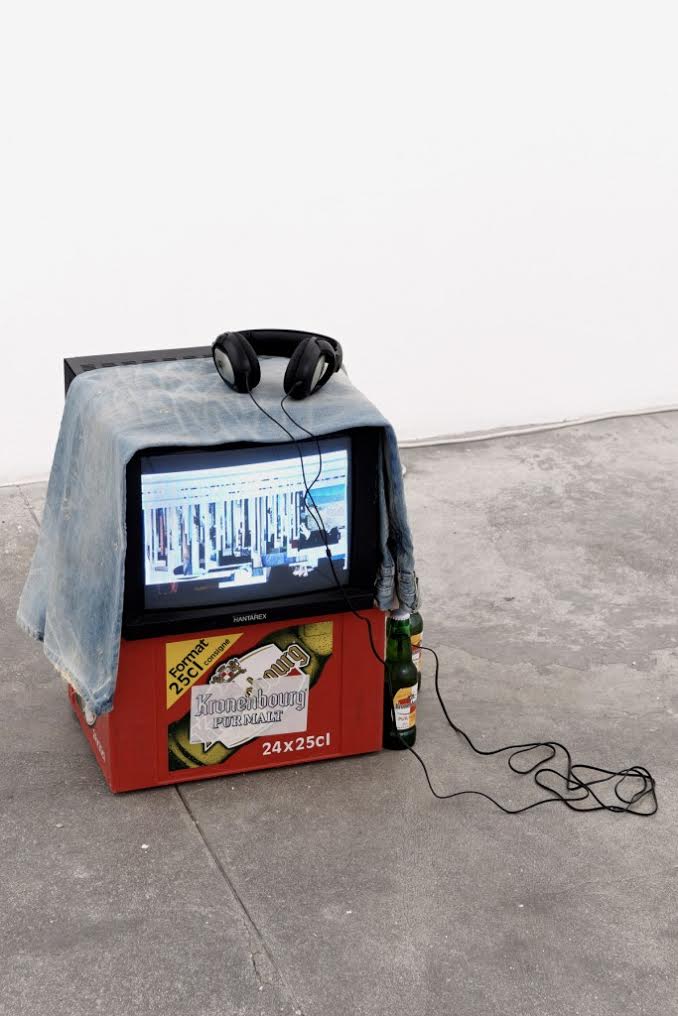
David Raymond Conroy, Act Natural, 2011 – 12Video: Hauling Audio Monologue: It is not the past, but the future that determines the present Display Unit: Act natural, or Proposal for a Display Unit Unique. Courtesy of the artist and Seventeen Gallery
What is the function of language in your work?
I like language because it has the feeling of being direct and of being clear, but as soon as I try to put it into action I find that things get complicated. Perhaps I mean it has the potential to feel very straightforward because we are so steeped in it and I like the feeling that that creates, of everydayness, and of transparency. Also, I think that in my work it has the function of keeping moving things forward and of creating quite clear entry points and exit points. I really like looking at art and I’m totally fascinated by it, but I often find myself thinking about practices that I dislike, and elements of the art world that aren’t for me, so perhaps that is why, in my own work, my touchstones come from less esoteric cultural forms – things like storytelling, and stand-up and song writing. I tend to start thinking in quite a linear way and then tracking back, re-looking or trying to strategise, but I always want to let people have access to these movements and language feels like the way that I can do this most adequately. In terms of why I have often spoken in my work – why my voice appears – that has to do with a few things. Firstly, speed and economy for sure, but also I thought that how I talk, my accent and my vocabulary, are things I wanted to bring into play, because they are things that make me feel self-conscious in my real world. I remember reading an interview with Felix Gonzalez-Torres where he said “Your limitations should be your strengths” and I guess I took that to heart.
What are you working on now?
I thought for this year I wanted to take some time out and kind of take stock and think about what I want to do with my next work, so I put all of my projects off until 2018, which seemed forever away but suddenly starts to loom large. Right now, I’m lucky enough to be at Hospitalfield in Arbroath working on quite a few things simultaneously, which is quite unlike me. Primarily I’m working on a piece about ghosting. Strangely enough this has involved me making a lot of paintings, which for all of my unease about sitting in the studio alone has been absolutely blissful. So, in the first half of the year I’ll be getting that together and I’ll have a new show at Seventeen, also together with Cally Spooner, Ghislaine Leung and Jesper List Thomsen we’re working on a group project for Reading International. So those and a couple of other things that are still under wraps, at the moment it looks like it’ll be an interesting year.

